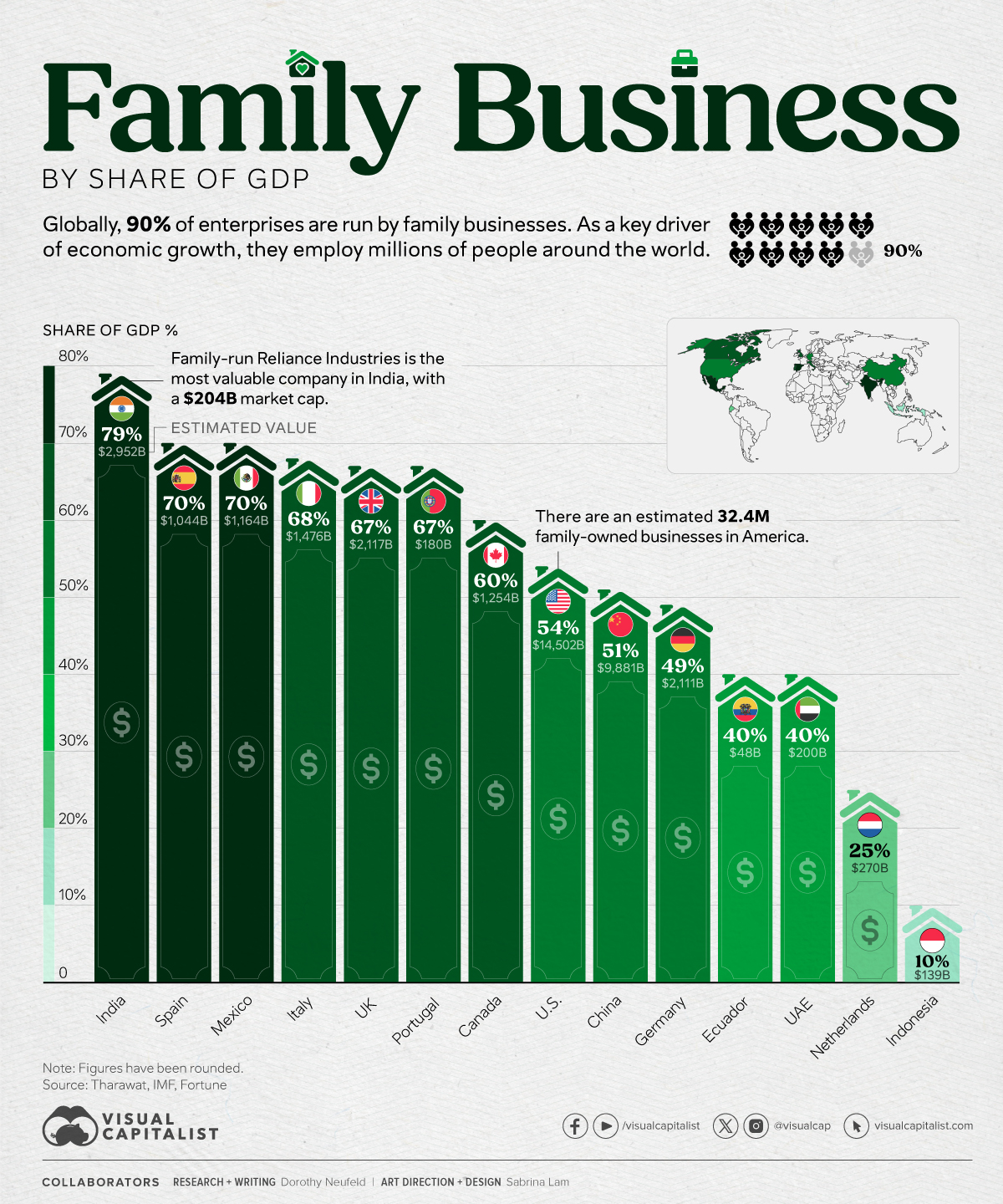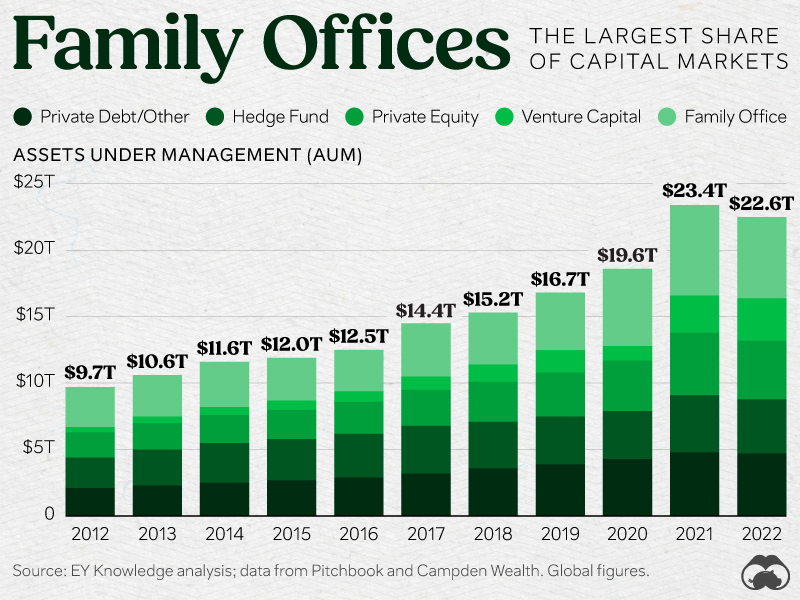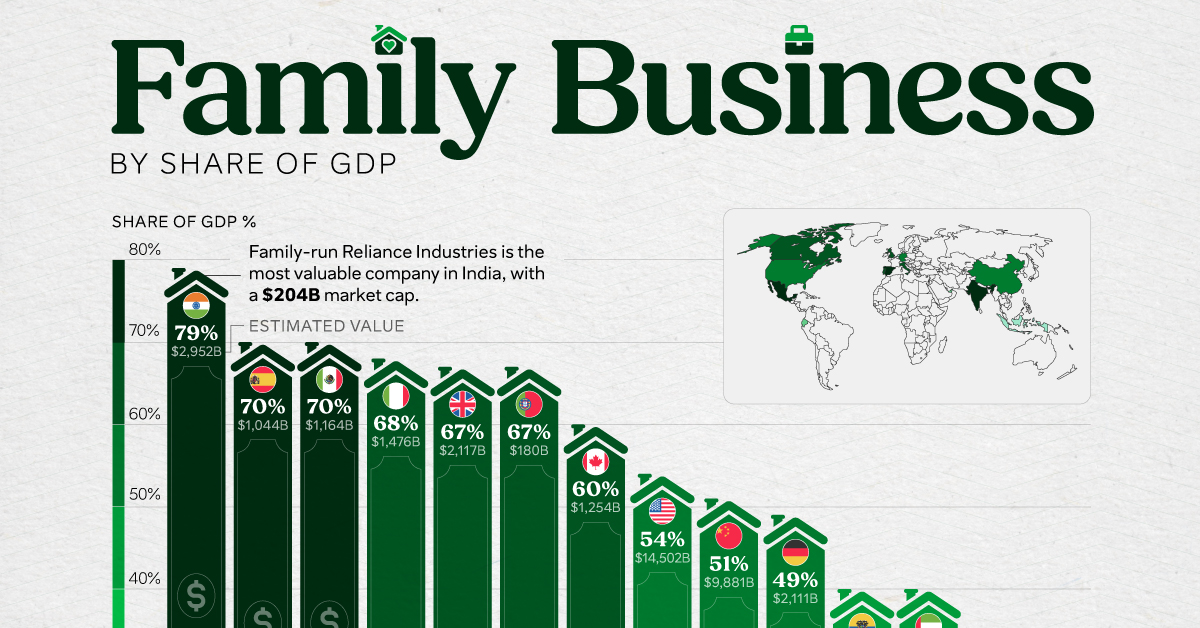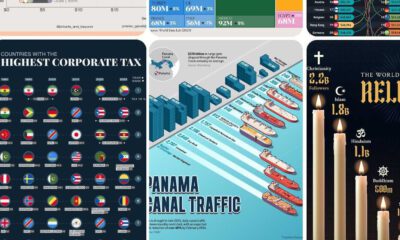Markets
The Influence of Family-Owned Businesses, by Share of GDP

Family-Owned Businesses, by Share of GDP
In many ways, the engine of global economic growth is hidden in plain sight.
Family-owned businesses, which make up 90% of global enterprises, have driven job creation and entrepreneurship over history. While the majority of these are mom-and-pop shops, some of the world’s largest companies, from Walmart to Ford, are family-run.
This graphic shows the economic influence of family businesses in select countries, with analysis from Tharawat.
Family Businesses and the World Economy
Below, we show the economic contribution of family businesses around the world:
| Country | Family Business Share of GDP | GDP 2023 | Estimated Contribution to GDP |
|---|---|---|---|
| 🇮🇳 India | 79% | $3,737B | $2,952B |
| 🇪🇸 Spain | 70% | $1,492B | $1,044B |
| 🇲🇽 Mexico | 70% | $1,663B | $1,164B |
| 🇮🇹 Italy | 68% | $2,170B | $1,476B |
| 🇬🇧 UK | 67% | $3,159B | $2,117B |
| 🇵🇹 Portugal | 67% | $268B | $180B |
| 🇨🇦 Canada | 60% | $2,090B | $1,254B |
| 🇺🇸 U.S. | 54% | $26,855B | $14,502B |
| 🇨🇳 China | 51% | $19,374B | $9,881B |
| 🇩🇪 Germany | 49% | $4,309B | $2,111B |
| 🇪🇨 Ecuador | 40% | $121B | $48B |
| 🇦🇪 UAE | 40% | $499B | $200B |
| 🇳🇱 Netherlands | 25% | $1,081B | $270B |
| 🇮🇩 Indonesia | 10% | $1,392B | $139B |
As the above table shows, 79% of India’s economic output is fueled by family-owned businesses, the highest across the dataset.
Reliance Industries is the largest family enterprise in the country, and the 10th-largest globally. Founded in 1973, it is run by the Ambani family and has a $204 billion market capitalization as of December 2023.
Following India are Spain and Mexico, with family businesses making up 70% of GDP and contributing over $1 trillion to these economies each year.
In the U.S., an estimated 32.4 million businesses are family-owned that collectively generate $14.5 trillion in GDP. The largest of these enterprises are Walmart, Berkshire Hathaway, and Cargill.
Family Offices in Private Capital Markets
Just as family businesses have significant influence over global GDP, family offices also own a large portion of global assets.

In fact, they make 27% of private capital markets globally, with $6.1 trillion in assets under management—more than doubling over the last decade.
While the majority of family office assets are invested in funds, there is a growing trend of investing directly in target companies, such as tech start-ups.
By 2027, Ernst & Young projects that private markets will expand considerably, facing a similar trend seen over the last decade—with family offices playing a key role in driving this growth.
Markets
The European Stock Market: Attractive Valuations Offer Opportunities
On average, the European stock market has valuations that are nearly 50% lower than U.S. valuations. But how can you access the market?

European Stock Market: Attractive Valuations Offer Opportunities
Europe is known for some established brands, from L’Oréal to Louis Vuitton. However, the European stock market offers additional opportunities that may be lesser known.
The above infographic, sponsored by STOXX, outlines why investors may want to consider European stocks.
Attractive Valuations
Compared to most North American and Asian markets, European stocks offer lower or comparable valuations.
| Index | Price-to-Earnings Ratio | Price-to-Book Ratio |
|---|---|---|
| EURO STOXX 50 | 14.9 | 2.2 |
| STOXX Europe 600 | 14.4 | 2 |
| U.S. | 25.9 | 4.7 |
| Canada | 16.1 | 1.8 |
| Japan | 15.4 | 1.6 |
| Asia Pacific ex. China | 17.1 | 1.8 |
Data as of February 29, 2024. See graphic for full index names. Ratios based on trailing 12 month financials. The price to earnings ratio excludes companies with negative earnings.
On average, European valuations are nearly 50% lower than U.S. valuations, potentially offering an affordable entry point for investors.
Research also shows that lower price ratios have historically led to higher long-term returns.
Market Movements Not Closely Connected
Over the last decade, the European stock market had low-to-moderate correlation with North American and Asian equities.
The below chart shows correlations from February 2014 to February 2024. A value closer to zero indicates low correlation, while a value of one would indicate that two regions are moving in perfect unison.
| EURO STOXX 50 | STOXX EUROPE 600 | U.S. | Canada | Japan | Asia Pacific ex. China |
|
|---|---|---|---|---|---|---|
| EURO STOXX 50 | 1.00 | 0.97 | 0.55 | 0.67 | 0.24 | 0.43 |
| STOXX EUROPE 600 | 1.00 | 0.56 | 0.71 | 0.28 | 0.48 | |
| U.S. | 1.00 | 0.73 | 0.12 | 0.25 | ||
| Canada | 1.00 | 0.22 | 0.40 | |||
| Japan | 1.00 | 0.88 | ||||
| Asia Pacific ex. China | 1.00 |
Data is based on daily USD returns.
European equities had relatively independent market movements from North American and Asian markets. One contributing factor could be the differing sector weights in each market. For instance, technology makes up a quarter of the U.S. market, but health care and industrials dominate the broader European market.
Ultimately, European equities can enhance portfolio diversification and have the potential to mitigate risk for investors.
Tracking the Market
For investors interested in European equities, STOXX offers a variety of flagship indices:
| Index | Description | Market Cap |
|---|---|---|
| STOXX Europe 600 | Pan-regional, broad market | €10.5T |
| STOXX Developed Europe | Pan-regional, broad-market | €9.9T |
| STOXX Europe 600 ESG-X | Pan-regional, broad market, sustainability focus | €9.7T |
| STOXX Europe 50 | Pan-regional, blue-chip | €5.1T |
| EURO STOXX 50 | Eurozone, blue-chip | €3.5T |
Data is as of February 29, 2024. Market cap is free float, which represents the shares that are readily available for public trading on stock exchanges.
The EURO STOXX 50 tracks the Eurozone’s biggest and most traded companies. It also underlies one of the world’s largest ranges of ETFs and mutual funds. As of November 2023, there were €27.3 billion in ETFs and €23.5B in mutual fund assets under management tracking the index.
“For the past 25 years, the EURO STOXX 50 has served as an accurate, reliable and tradable representation of the Eurozone equity market.”
— Axel Lomholt, General Manager at STOXX
Partnering with STOXX to Track the European Stock Market
Are you interested in European equities? STOXX can be a valuable partner:
- Comprehensive, liquid and investable ecosystem
- European heritage, global reach
- Highly sophisticated customization capabilities
- Open architecture approach to using data
- Close partnerships with clients
- Part of ISS STOXX and Deutsche Börse Group
With a full suite of indices, STOXX can help you benchmark against the European stock market.

Learn how STOXX’s European indices offer liquid and effective market access.

-

 Economy3 days ago
Economy3 days agoEconomic Growth Forecasts for G7 and BRICS Countries in 2024
The IMF has released its economic growth forecasts for 2024. How do the G7 and BRICS countries compare?
-

 Markets2 weeks ago
Markets2 weeks agoU.S. Debt Interest Payments Reach $1 Trillion
U.S. debt interest payments have surged past the $1 trillion dollar mark, amid high interest rates and an ever-expanding debt burden.
-

 United States2 weeks ago
United States2 weeks agoRanked: The Largest U.S. Corporations by Number of Employees
We visualized the top U.S. companies by employees, revealing the massive scale of retailers like Walmart, Target, and Home Depot.
-

 Markets2 weeks ago
Markets2 weeks agoThe Top 10 States by Real GDP Growth in 2023
This graphic shows the states with the highest real GDP growth rate in 2023, largely propelled by the oil and gas boom.
-

 Markets2 weeks ago
Markets2 weeks agoRanked: The World’s Top Flight Routes, by Revenue
In this graphic, we show the highest earning flight routes globally as air travel continued to rebound in 2023.
-

 Markets3 weeks ago
Markets3 weeks agoRanked: The Most Valuable Housing Markets in America
The U.S. residential real estate market is worth a staggering $47.5 trillion. Here are the most valuable housing markets in the country.
-

 Debt1 week ago
Debt1 week agoHow Debt-to-GDP Ratios Have Changed Since 2000
-

 Markets2 weeks ago
Markets2 weeks agoRanked: The World’s Top Flight Routes, by Revenue
-

 Countries2 weeks ago
Countries2 weeks agoPopulation Projections: The World’s 6 Largest Countries in 2075
-

 Markets2 weeks ago
Markets2 weeks agoThe Top 10 States by Real GDP Growth in 2023
-

 Demographics2 weeks ago
Demographics2 weeks agoThe Smallest Gender Wage Gaps in OECD Countries
-

 United States2 weeks ago
United States2 weeks agoWhere U.S. Inflation Hit the Hardest in March 2024
-

 Green2 weeks ago
Green2 weeks agoTop Countries By Forest Growth Since 2001
-

 United States2 weeks ago
United States2 weeks agoRanked: The Largest U.S. Corporations by Number of Employees













